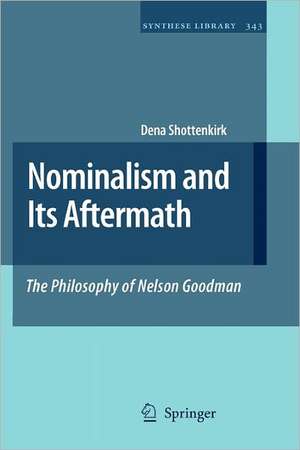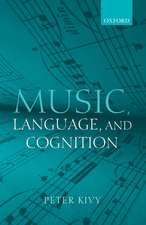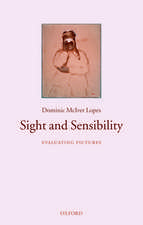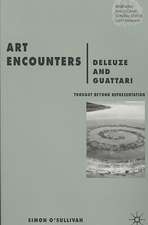Nominalism and Its Aftermath: The Philosophy of Nelson Goodman: Synthese Library, cartea 343
Autor Dena Shottenkirken Limba Engleză Paperback – 28 oct 2010
This book will benefit not only the professionals in the field of philosophy, but will also help both graduate and upper level undergraduate students understand Goodman’s disparate writings within their proper context, and hopefully will also encourage them to view philosophical thinking in a less truncated and departmentalized way.
| Toate formatele și edițiile | Preț | Express |
|---|---|---|
| Paperback (1) | 630.47 lei 6-8 săpt. | |
| SPRINGER NETHERLANDS – 28 oct 2010 | 630.47 lei 6-8 săpt. | |
| Hardback (1) | 630.41 lei 6-8 săpt. | |
| SPRINGER NETHERLANDS – 18 iun 2009 | 630.41 lei 6-8 săpt. |
Din seria Synthese Library
-
 Preț: 543.27 lei
Preț: 543.27 lei - 15%
 Preț: 633.74 lei
Preț: 633.74 lei - 18%
 Preț: 973.28 lei
Preț: 973.28 lei - 15%
 Preț: 586.66 lei
Preț: 586.66 lei - 18%
 Preț: 897.28 lei
Preț: 897.28 lei - 15%
 Preț: 582.57 lei
Preț: 582.57 lei - 15%
 Preț: 691.36 lei
Preț: 691.36 lei - 18%
 Preț: 886.33 lei
Preț: 886.33 lei - 15%
 Preț: 638.61 lei
Preț: 638.61 lei -
 Preț: 282.33 lei
Preț: 282.33 lei -
 Preț: 439.86 lei
Preț: 439.86 lei - 5%
 Preț: 369.46 lei
Preț: 369.46 lei - 15%
 Preț: 626.86 lei
Preț: 626.86 lei - 18%
 Preț: 942.69 lei
Preț: 942.69 lei - 15%
 Preț: 631.54 lei
Preț: 631.54 lei - 18%
 Preț: 1209.87 lei
Preț: 1209.87 lei - 15%
 Preț: 632.01 lei
Preț: 632.01 lei - 18%
 Preț: 983.50 lei
Preț: 983.50 lei -
 Preț: 383.18 lei
Preț: 383.18 lei - 15%
 Preț: 626.55 lei
Preț: 626.55 lei - 18%
 Preț: 936.20 lei
Preț: 936.20 lei - 18%
 Preț: 1210.53 lei
Preț: 1210.53 lei - 15%
 Preț: 641.21 lei
Preț: 641.21 lei -
 Preț: 392.95 lei
Preț: 392.95 lei -
 Preț: 397.54 lei
Preț: 397.54 lei - 18%
 Preț: 1204.79 lei
Preț: 1204.79 lei - 15%
 Preț: 628.14 lei
Preț: 628.14 lei - 18%
 Preț: 1211.29 lei
Preț: 1211.29 lei -
 Preț: 377.66 lei
Preț: 377.66 lei -
 Preț: 391.98 lei
Preț: 391.98 lei - 15%
 Preț: 629.60 lei
Preț: 629.60 lei - 15%
 Preț: 628.32 lei
Preț: 628.32 lei -
 Preț: 379.18 lei
Preț: 379.18 lei - 15%
 Preț: 632.17 lei
Preț: 632.17 lei
Preț: 630.47 lei
Preț vechi: 741.73 lei
-15% Nou
Puncte Express: 946
Preț estimativ în valută:
120.72€ • 124.53$ • 100.05£
120.72€ • 124.53$ • 100.05£
Carte tipărită la comandă
Livrare economică 20 februarie-06 martie
Preluare comenzi: 021 569.72.76
Specificații
ISBN-13: 9789048182237
ISBN-10: 9048182239
Pagini: 188
Ilustrații: XIV, 174 p.
Dimensiuni: 155 x 235 x 10 mm
Greutate: 0.27 kg
Ediția:Softcover reprint of hardcover 1st ed. 2009
Editura: SPRINGER NETHERLANDS
Colecția Springer
Seria Synthese Library
Locul publicării:Dordrecht, Netherlands
ISBN-10: 9048182239
Pagini: 188
Ilustrații: XIV, 174 p.
Dimensiuni: 155 x 235 x 10 mm
Greutate: 0.27 kg
Ediția:Softcover reprint of hardcover 1st ed. 2009
Editura: SPRINGER NETHERLANDS
Colecția Springer
Seria Synthese Library
Locul publicării:Dordrecht, Netherlands
Public țintă
ResearchCuprins
The Metaphysics.- The Basic Problem.- Goodman’s Nominalism.- The Consequences of Goodman’s Nominalism for his Terminology.- The Epistemology.- Twentieth Century Epistemology.- Constructionalism.- The Effects of Goodman’s Nominalist Constructionalism on his Epistemology.- Influences on Goodman’s Philosophy.- The Effects of Goodman’s Epistemology on his Terminology/Concepts.- The Aesthetics.- Goodman’s Expression as Reference.- Goodman’s Metaphorical Exemplification.- Aesthetics as a Branch of Epistemology.- The Effects of Goodman’s Nominalism and Worldmaking on his Aesthetics.
Recenzii
From the reviews:
"The author has given us the needed scholarly reference work on Goodman. Goodman sought to replace psychology with semantics, and showed us how far we could travel in that direction. The trip was admirably designed and guided by his genius. In end, it was genius, and not the lack of it, that showed us that the philosophy of language and languages of art will lead us back to the hardest questions in the philosophy of mind."
Keith Lehrer, Regents Professor of Philosophy, The University of Arizona
“The central aim of Shottenkirk’s book is then to present the different aspects but also the consistency and unity of Goodman’s philosophy … . Shottenkirk’s book is … a fine piece of Goodman scholarship, highlighting the philosopher’s genius through a comprehensive, thorough and lucid analysis of his work. It will be valuable to the student but also the philosopher who wants to gain a good overview of Goodman’s philosophy as well as grasp the numerous intricate links between the different aspects of his thought.” (Katerina Bantinaki, Metascience, Vol. 20, 2011)
"The author has given us the needed scholarly reference work on Goodman. Goodman sought to replace psychology with semantics, and showed us how far we could travel in that direction. The trip was admirably designed and guided by his genius. In end, it was genius, and not the lack of it, that showed us that the philosophy of language and languages of art will lead us back to the hardest questions in the philosophy of mind."
Keith Lehrer, Regents Professor of Philosophy, The University of Arizona
“The central aim of Shottenkirk’s book is then to present the different aspects but also the consistency and unity of Goodman’s philosophy … . Shottenkirk’s book is … a fine piece of Goodman scholarship, highlighting the philosopher’s genius through a comprehensive, thorough and lucid analysis of his work. It will be valuable to the student but also the philosopher who wants to gain a good overview of Goodman’s philosophy as well as grasp the numerous intricate links between the different aspects of his thought.” (Katerina Bantinaki, Metascience, Vol. 20, 2011)
Notă biografică
Dr. Shottenkirk, like Nelson Goodman, is not only a philosopher but also has experience within tthe artworld. She is both an exhibiting artist and an art critic who has written extensively in major art criticism publications, such as Artforum and Art in America. This uniquely positions her to understand and evaluate Goodman’s broad range of thought, most especially his aesthetics.
Textul de pe ultima copertă
Nelson Goodman’s disparate writings are often written about only within their own particular discipline, such that the epistemology is discussed in contrast to others’ epistemology, the aesthetics is contrasted with more traditional aesthetics, and the ontology and logic is viewed in contrast to both other contemporary philosophers and to Goodman’s historical predecessors. This book argues that that is not an adequate way to view Goodman. The separate disciplines of ontology, epistemology, and aesthetics should be viewed as sequential steps within his thought, such that each provides the ground rules for the next section and, furthermore, providing the reasons for limitations on the terms available to the subsequent writing(s). This is true not merely because this is the general chronology of his writing, but more importantly because within his metaphysics lies Goodman’s basic nominalist ontology and logic, and it is upon those principles that he builds his epistemology and, furthermore, it is the sum of both the metaphysics and the epistemology, with the nominalist principle as the guiding force, which constructs the aesthetics. At the end of each section of this book, the consequent limitations imposed on his terms and concepts available to him are explicated, such that, by the end of the book, the book delineates the constraints imposed upon the aesthetics by both the metaphysics and the epistemology.
"The author has given us the needed scholarly reference work on Goodman. Goodman sought to replace psychology with semantics, and showed us how far we could travel in that direction. The trip was admirably designed and guided by his genius. In end, it was genius, and not the lack of it, that showed us that the philosophy of language and languages of art will lead us back to the hardest questions in the philosophy of mind." Keith Lehrer, Regents Professor of Philosophy, The University of Arizona
"The author has given us the needed scholarly reference work on Goodman. Goodman sought to replace psychology with semantics, and showed us how far we could travel in that direction. The trip was admirably designed and guided by his genius. In end, it was genius, and not the lack of it, that showed us that the philosophy of language and languages of art will lead us back to the hardest questions in the philosophy of mind." Keith Lehrer, Regents Professor of Philosophy, The University of Arizona
Caracteristici
Explains the interdependence of all of Goodman’s thought First book to offer a complete analysis of the effects of Goodman’s nominalism on his epistemology and aesthetics Gives the reader a genuine understanding of Goodman’s aesthetics because it is placed within the context of his ontology and epistemology Demonstrates that aesthetics is not a field isolated and afar from the rest of philosophy In arguing for aesthetics as a branch of epistemology, this book demonstrates the reliance of the former on the latter




















